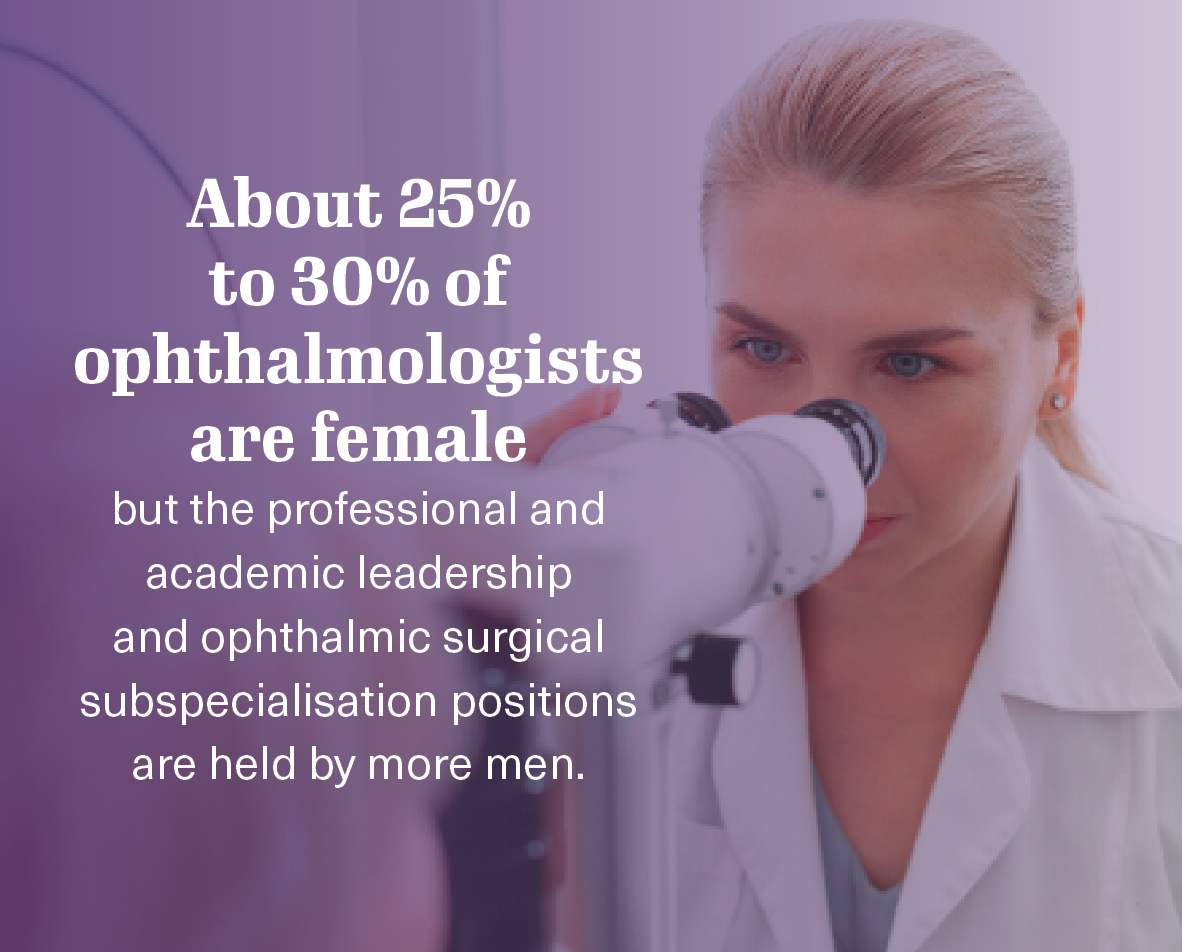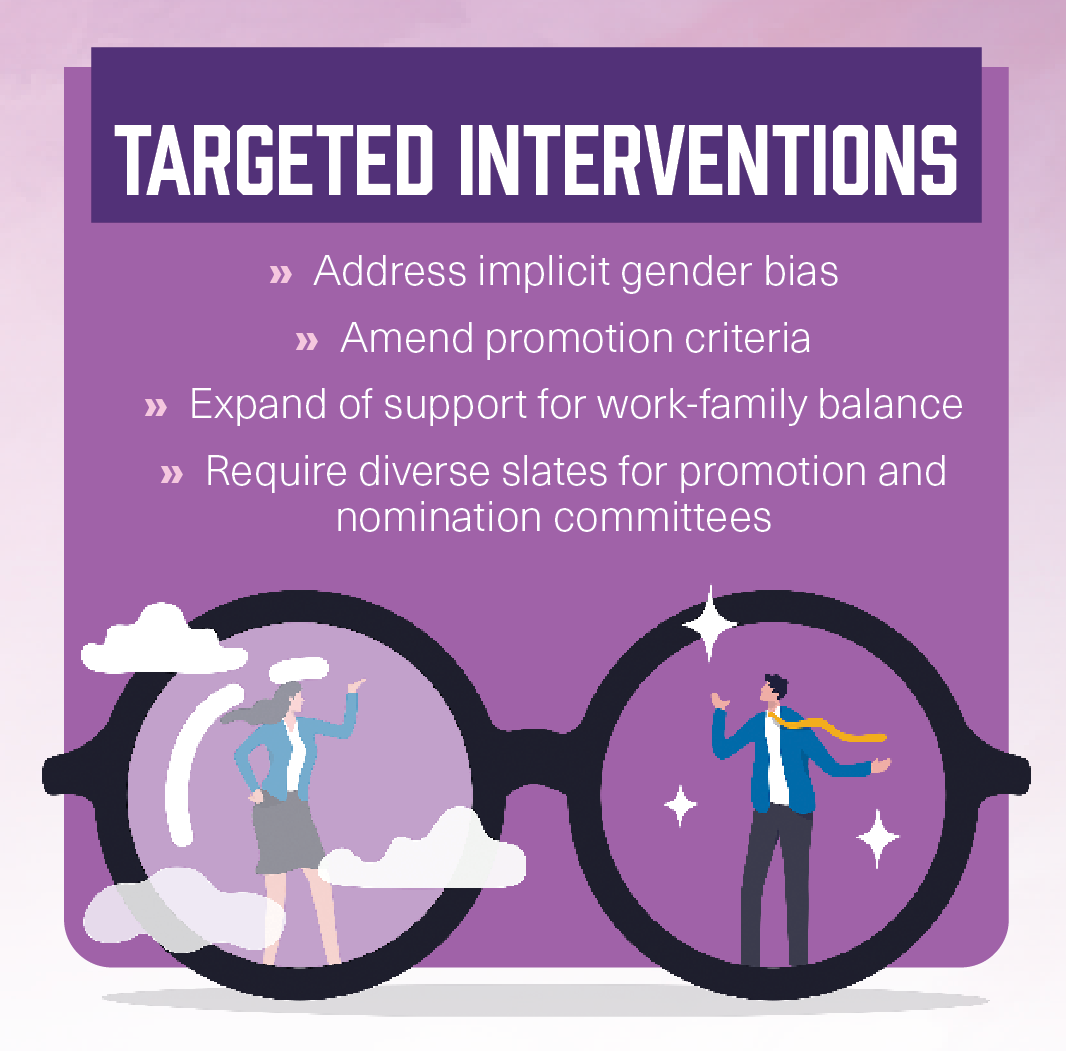Where women stand: A progress report on gender equity in ophthalmology
Mentorship, leadership and addressing bias are key areas for improvement
Globally, 8 March is recognised as International Women's Day. This presents an opportunity to identify methods of improving parity for women in ophthalmology. The results of a recent survey,1 Women in Ophthalmology, spearheaded by Johnson & Johnson and presented at the 2023 American Academy of Ophthalmology (AAO) annual meeting, identified barriers faced by women in the specialty.

Most of the 100 respondents believe they would have better professional experience if their mentors were women, but only 26% received mentorship. Other key findings were that 56% aspired to mentor new ophthalmologists and 36% recognised the glass ceiling that prevents women from achieving their career aspirations.
Another recent survey2 identified areas in ophthalmology in which women have gained ground. The authors found that currently about 25% to 30% of ophthalmologists are female, but the professional and academic leadership and ophthalmic surgical subspecialisation positions are held by more men.
The evidence also suggested that women experience more bias and discrimination in ophthalmology, which includes a pay gap.
In addition, differences in training between men and women ophthalmologists and trainees included “fewer opportunities to operate, more bullying and harassment, less access to mentorship, and contrasting expectations around contributions to family life.” The authors concluded that there are opportunities for improvement in these areas.
A study3 of the numbers of women in ophthalmology, i.e. female applicants, residents and medical school clinical faculty, found that the numbers was not proportional to the number of women in the general population, a key finding.

“Most notably,” according to the authors, “the percentage of female residents has been decreasing since 2011” and they call for actions to remedy this.
In this large study, women always constituted less than half of the groups evaluated, ie, of 2,807 ophthalmology applicants, 35.3% were women; of over 1 million residents, 43.8% were women; of almost a half million clinical faculty members, 42.5% were women; and of about 79,000 AAO members, 26.1% were women.
The data also showed a 2.5% decrease in the percentage of female residents in ophthalmology from 2011 to 2019, and a 2% increase in the percentage of female ophthalmology clinical faculty was seen from 2017 to 2019.
From 2016 to 2019, the ratio of male to female practicing ophthalmologists in the AAO was 3:1.
International data
A study conducted outside of the US showed the same basic trend, ie, that the numbers of women in ophthalmology and optometry who held leadership positions in the International Council of Ophthalmology (ICO) and the World Council of Optometry (WCO) were lower than the numbers of men.4
This cross-sectional study looked at the genders and ethnicities of board members and chairs of ICO and WCO member organisations during February and March 2020. The investigators calculated the gender proportions across Global Burden of Disease super regions, and gender and ethnicity proportions in wealthy areas of Australasia, North America and Western Europe.
The results indicated that “Globally, approximately one in three board members were women for both ICO (34%) and WCO (35%) members, and one in three ICO (32%) and one in five WCO (22%) chairpersons were women.”
In Latin America and the Caribbean, women held at least 50% of posts in only three of the 26 (12%) leadership structures assessed. In Southeast Asia, East Asia and Oceania, they held 55% of the ICO chairs. In Western Europe, White men predominated over board (56%) and chair (58%) positions; white women held a further quarter of positions (26% of board and 27% of chair). Women in minority groups held the fewest numbers of board (6%) and chair (7%) positions.
As in other studies, the authors called for improved gender parity in member organisations of the WCO and ICO worldwide. “Potential strategies to enable inclusive leadership must be centred on structurally enabled diversity and inclusion goals to support the professional progression of women, and people from ethnic minorities in global optometry and ophthalmology,” they concluded.
Some positive notes
Azad and colleagues5 reported that female representation has increased over the last 20 years among ophthalmology subspecialty society new membership, award winners, and executive committee membership; however, proportional representation is still lacking at most benchmarks.
This retrospective study included data from the American Society of Ophthalmic Plastic and Reconstructive Surgery (ASOPRS), American Association for Pediatric Ophthalmology and Strabismus (AAPOS), American Society of Cataract and Refractive Surgery (ASCRS), American Glaucoma Society, North American Neuro-Ophthalmology Society (NANOS) and American Society of Retina Specialists (ASRS). Data were missing for some of the societies.

Total membership parity for the period from 2000 to 2020 was achieved within AAPOS, but not in NANOS, ASCRS, or ASOPRS. Overall, new female membership increased from 42.2%from 200 to 2009 to 53.6% by 2019.
AAPOS was largely responsible for the significant increase in the number of female award winners from 23.1% to 39.9% between the 2 decades studied. However, that trend was not seen in AAPOS, ASOPRS and ASCRS.
A significant increase was seen in the percentage of women who held executive committee positions, largely based on the women who held those positions in ASOPRS and ASRS. This was not seen in NANOS and AAPOS. The percentage of women who were society presidents remained stable, with only ASOPRS having a significant increase in the number of female presidents between decades.
“This study celebrates the progress made toward gender parity, identifies areas of residual disparity, and highlights opportunities to attain proportional representation in benchmarks for both genders,” the investigators commented. Importantly, they noted that parity for women is not based solely on increasing memberships in various societies. “Women are still underrepresented relative to men even when membership gender parity is achieved, as evidenced by trends in AAPOS,” they said.
They suggested targeted interventions; for example, addressing implicit bias, amending promotion criteria, expanding support for work-family balance and requiring diverse slates for promotion and nomination committees can help bridge the gender gap.
“Though there is much to celebrate in the progress already made, these endeavours require the continued support and dedicated efforts of men and women within ophthalmology to achieve gender parity,” the authors concluded.
References
1. Johnson & Johnson vision survey highlights barriers faced by women in ophthalmology. News release. October 23, 2023. Accessed February 21, 2024. https://www.jjvision.com/press-release/johnson-johnson-vision-survey-highlights-barriers-faced-women-ophthalmology
2. Gill HK,Niederer RL, Shriver EM, et al. An eye on gender equality: a review of the evolving role and representation of women in ophthalmology. Am J Ophthalmol. 2022;236:232-240; DOI: 10.1016/j.ajo.2021.07.006
3. Aquwa UT, Srikumaran D, Green LK, et al. Analysis of sex diversity trends among ophthalmology match applicants, residents, and clinical faculty. JAMA Ophthalmol. 2021;139:1184-1190. doi:10.1001/jamaophthalmol.2021.3729
4. Yashadhana A, Clarke NA, Zhang JH, et al. Gender and ethnic diversity in global ophthalmology and optometry association leadership: a time for change. Ophthalmic Physiol Opt. 2021;41:623-629; doi: 10.1111/opo.12793
5. Azad AD, Chandramohan A, Li AS, et al. Representation of women in ophthalmology subspecialty societies over 20 years. Ophthalmology. 2022;129:587-590; doi:10.1016/j.ophtha.2021.12.011
